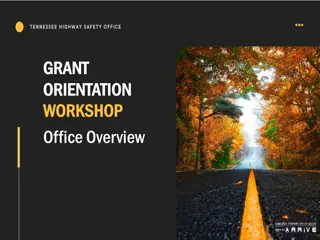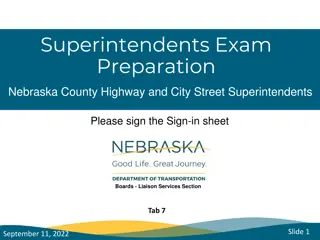Understanding Highway Engineering: Concepts and Organizations in India
Highway engineering involves the design, construction, and maintenance of roads for various modes of transportation. Important terms, organizations like India Road Congress, and the Central Road Research Institute play vital roles in promoting road development in India.
- Highway Engineering
- Road Construction
- India Road Congress
- Road Development
- Central Road Research Institute
Download Presentation

Please find below an Image/Link to download the presentation.
The content on the website is provided AS IS for your information and personal use only. It may not be sold, licensed, or shared on other websites without obtaining consent from the author. Download presentation by click this link. If you encounter any issues during the download, it is possible that the publisher has removed the file from their server.
E N D
Presentation Transcript
HIGHWAY ENGINEERING
CONTENTS Introductions Road Geometrics Highway Surveys and plan Road Material
INTRODUCTION Highway Engineering : - The branch of science or engineering which deals with the art of design , construction and maintenance of roads of different kinds is termed as Highway Engineering. Modes Of Transportation 1. Railways 2. Waterways 3. Airways
IMPORTANT TERMS USED IN HIGHWAY ENGINEERING Road :- Road is defined as a structure as a constructed of different material to facilitate movement of vehicle, carts , cyclists, pedestrians etc. from on place to another. Traffic :- The motor vehicles of different kinds such as carts, cyclists and pedestrians moving together on a road is termed as traffic .
o Right of way :- The privilege to use road by the traffic is termed as right of way . o Street :- A road in a built up area or town is termed as street. o Carriage way :- The part of road, which is used only by vehicular traffic i.e. bullock carts and motor vehicles etc. is known as carriage way. o Foot path :- The part of road used by pedestrians or general people walking on foot is termed as foot path.
FUCTIONS OF IMPORTANT ORGANISTIONS PROMOTING ROAD DEVELOPMENT IN INDIA INDIA ROAD CONGRESS (I.R.C) : As per the recommendations made by the Jayakar Committee, a semi-government body was formed in 1934 to provide a platform for regular sharing of ideas and experience on all matters related to planning, construction and maintenance of roads in India. The body was named as India Road Congress (I.R.C)
Function of I.R.C : To collect information and literature on roads and make it available for use in the country. To recommend standard specifications for road materials, design and construction techniques. To determine the nature and extent of research. To channelise consulative service on road research.
Central road research institute (C.R.R.I) :- In 1950, C.R.R.I was set up at okhla near delhi situated on Delhi-Mathura road to carry out research on various aspects of road engineering. This institute inaugurated by late PM is financed and controlled by MOST and is one of the national laboratories of the Council of Scientific and Industrial Research . It may be indicated that like I.R.C., C.R.R.I. Was also set up on the recommendations of jayakar committee report as a central organization of information and research. The head of the institute is known as director. He is assisted by deputy director.
Functions of C.R.R.I : To carry out research on various aspects of Highway Engineering. To provide technical advice to State Government and Industries on various problems concerning roads such as traffic problems. To co-ordinate the activities of State Road Boards located at Kolkata , Chennai , Luck now and Patna.
National Highway Authority Of India (NHAI) : National Highway Authority Of India known as NHAI is an autonomous statutory organization which was established on 15th June ,1989 under National Highway Authority Of India Act 1988. It is working under guidance of Ministry of Surface Transport (MOST) and is responsible for development , maintenance and management of National Highways in India. Its head office is situated in New Delhi.
Functions Of NHAI : To develop , maintain , and manage National Highways in India. To implement National Highway development projects sectioned by MOST. To construct express ways. To invite tender and award projects to various highway building companies. To handle BOT projects(Build-Operate- Transfer).
IRC CLASSIFICATION OF ROAD NATIONAL HIGHWAY STATE HIGHWAY OR PROVINCIAL HIGHWAYS MAJOR DISTRICT ROAD OTHER DISTRICT ROAD VILLAGE ROAD
ORGANISATION OF STATE HIGHWAY DEPARTMENT
SCOPE OF HIGHWAY ENGINEERING :- Development, planning and location. Design of road geometrics Road economics Road specification Road bridges and culvert Road making materials Road administrations
ROAD GEOMETRICS Various Elements Of Road Geometrics Right of way Formation width Road margin Road shoulder Carriage Way Side slopes Kerbs Horizontal and vertical curve Formation level Camber Gradient Design and average running speed Stopping and passing sight distances Super elevation
TYPES OF CURVES: Horizontal Curves Vertical Curves Advantages of curves : To provide comfort to the passengers using roads on change of direction or grade. To alert the driver against any mishap due to change in the direction of road. To keep the speed of vehicles within limits.
SUPER ELEVATION: The transverse inclination provided to the pavement surface on curves by raising the outer edge with respect to the inner edge to counter act the centrifugal force and to reduce the tendency of vehicle to overturn is termed as SUPER ELEVATION
Methods of Super Elevation: Outer slope rotation method Diagonal curve method ADVANTAGES OF SUPER ELEVATION: The stability of fast moving vehicle is increased and their tendency to skid or overturn decreases. The distribution of pressure on both the wheels will be equal and thus wear and tear of vehicle decreases. Intensity of stresses on the foundation decreases.
HIGHWAYS SURVEYS AND PLANS : Highway survey or road survey and infact highway planning is essential for a new road project. Road project means planning, designing and construction of a new road connecting to terminal points or town with the existing road network. Road survey are generally under taken to collect the necessary data and to determine the location of a proposed road.
Assessment of road length requirement in a village, district, state or entire country. Preparation of master plan of entire road project. The road project includes the following: Preparation of Topographic map Road alignment. III. Estimates and IV. Project report I. II.
TOPOGRAPHIC MAP A Map Showing the general details of an area such as building, roads, railway lines, sources of water, hospitals, schools, drainage structure etc. including contour lines is termed as topographic map. USES OF TOPOGRAPHIC MAP :- It helps to mark all the possible alignment and suggest the likely routes of the new road. It helps to finalize the road gradient. It helps to locate the position of bridges on the river or stream.
ROAD ALIGNMENT The route along which the centre line of a road is located in the plan or on the ground is termed as road alignment. Requirement of an ideal road alignment :- The road alignment b/w two station should be as short and straight as possible. The road alignment should be economical. The road alignment should be safe for traffic operations.
BASIC CONSIDERATION GOVERNING ALIGNMENT FOR A ROAD IN PLAIN AREA :- Factors 1 Obligatory points 2 Traffic consideration 3 Geometric Design Parameters 4 Economic Factors
STANDARDS FOR PREPARING HIGHWAY PLANS 1Preparation of highway plans 2 Master plan 3 Estimates 4 Project report
ROAD MATERIALS Road materials 1 Soil 2 Aggregates 3 Binders
TESTING OF ROAD MATERIALS 1 SOILS .. CBR Test 2 AGGREGATES .. Los angels abrasion test Impact test Crushing strength test Water absorption test Sound test
3 Binders Penetration test Ductility test Softening point viscosity test























